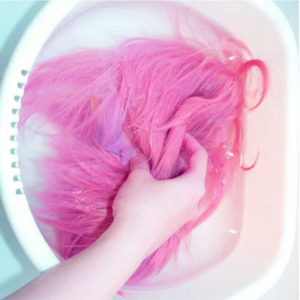We regularly get emails asking us whether it’s OK to dye one of our wigs. We usually reply to these with a “well we wouldn’t recommend it…” but we know there is a way that has been proven to work, and has been endorsed by our own customers, so we thought we would tell you how it’s done!

You’ll need:
A light coloured wig that is heat resistant (all Lush Wigs are) – one of our light blondes is most likely to take dye, never try and put colour into a wig that already has colour in it. It will just ruin the wig.
Fabric dye – look into a brand that others have used on wigs, this differs worldwide. NEVER USE REGULAR HAIR DYE ON SYNTHETIC HAIR – it will melt!
A large pot – big enough to stir the wig around in with plenty of room for all the hair. If the hair is crammed in, you might not get even colour coverage.
Put some old clothes on just in case!
Put your pot on the stove, and fill with enough water to completely cover your wig. Bring this water to the boil, then drop in your dye. You can control the colour at this stage, the more colour you add, the darker it’ll come out. If you want a washed out/pastel vibe, just a little will do.
As the water reaches boiling, run your wig under a tap to get it wet, this helps the dye take properly. Take the boiling pot off the heat, and put your wig in the water. Give it a mix around with a wooden spoon to make sure the colour gets to all the strands of hair. The longer it is in the water, the more of the colour it’ll take in. If you’ve made your water quite coloured and you only want a tint, take it out fairly quickly. It’s important that you keep an eye on the wig during this part, as it will determine how it looks, so remember not to leave it in too long if you don’t want an intense colour.
Once the wig looks the right colour, remove it from the water and rinse it under the cold tap. Do this until the water runs clear, like you would with regular hair dye. You can then lay your wig out and leave it to air dry.
This process is risky, factors like how well your wig has been looked after, the quality of fabric dye used etc. can all have an effect on the outcome, so please be careful, and as we said above, don’t do this on a wig you aren’t OK with potentially ruining. Having said that, it’s a great way to revive old styles you don’t wear anymore, and the boiling water can smooth out old synthetic hair, if your wig was styled in curls when you boiled it though, these curls will not still be present after it dries. This process removes any style the wig had been set into.
Have fun – if you do try it, good luck!
